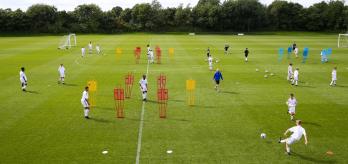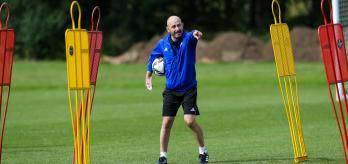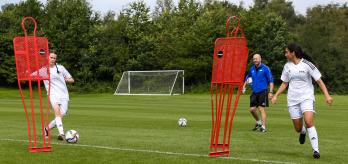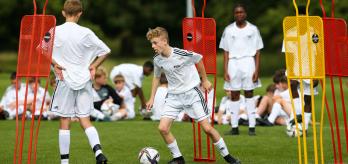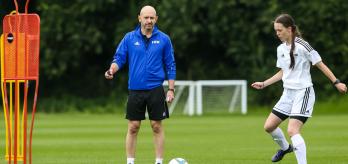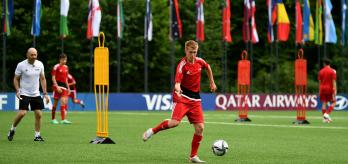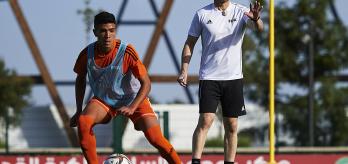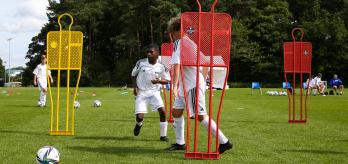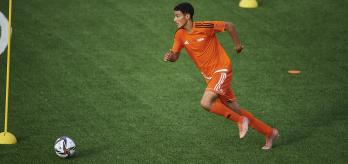The drills feature a great variety of movement and high-tempo passing combinations with a strong focus on promoting the technical understanding between players in terms of the timing of passes, movement and acceleration required when playing passes over distances of up to 40m or more.
This circuit, as is the case with all of the others in this series, can be set up in different sizes (small, medium and large) so as to allow for various ranges of passing and movement and different combinations. The circuit that features in this article is medium-sized.
Set-up for all drills
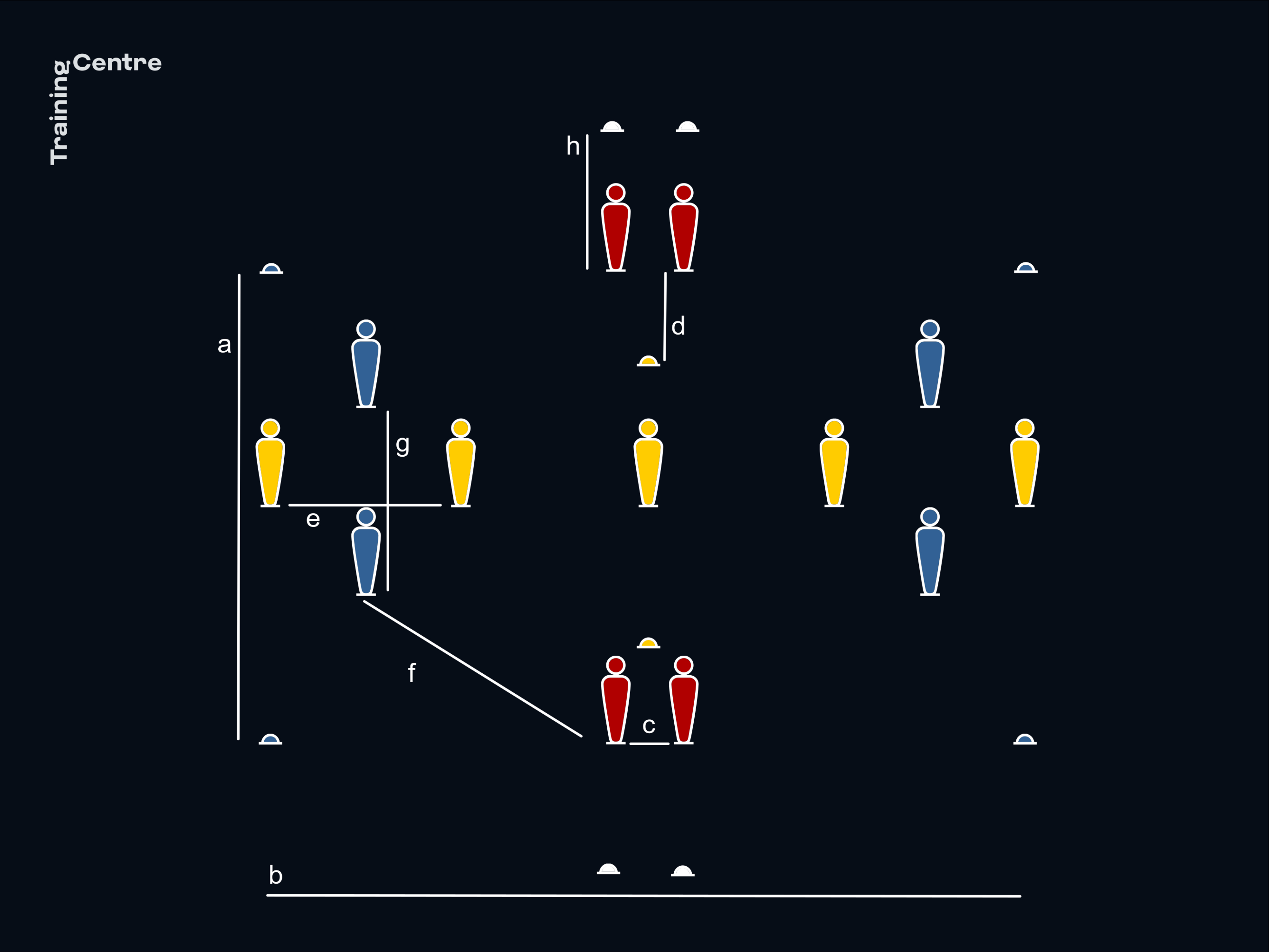
Organisation
- Lay out a 25x40m grid marked with flat blue cones (a: 25m and b: 40m).
- Create two, 2m-wide red mannequin gates (c) at the midpoint of the two 40m lines that are enclosed by blue cones at each corner (b).
- Place a flat yellow cone (d) 5m from each of the 2 red mannequin gates on the inside of the grid.
- Place two 10m-wide yellow mannequin gates (e) at the midpoint of both 25m lines (a).
- Create two 10m-wide blue mannequin gates (g) that lie 15m diagonally from the red mannequin gates (f).
- Place a gate comprising 2 flat white cones 7.5m from the 2 red mannequin gates to the outside of the grid (h).
- Complete the set-up by placing a single yellow mannequin halfway between the 2 yellow mannequin gates.
- If no mannequins are available, cones/discs or poles may be used instead.
Drill duration
- 7-8 players: 2-3 minutes on each side of the grid (left and right) after a period in which players are given the time to familiarise themselves with the scenario.
Approximate workload intensity
Fitness is a key element in these drills, which are to be completed at a high tempo.
- 7 players (optimum number): high repitition/medium to higher intensity.
- 8 players: lower to medium intensity.
Coaching points that apply to all drills
- Allow players 30 seconds to find their tempo and familiarise themselves with the scenario, before gradually raising the intensity demands.
- Devote a period of time (minimum of 1 minute) during each drill to focus on high tempo, correct technique, technical balance and reinforcement of awareness habits.
- Encourage players to move quickly between positions.
This circuit can be set up to involve a full squad comprising 20 players or more. Where this is the case, 2 circuits are required with 2 balls and 10-12 players involved in each circuit.
Drill 1: Switch play diagonally, turn and play forwards vertically
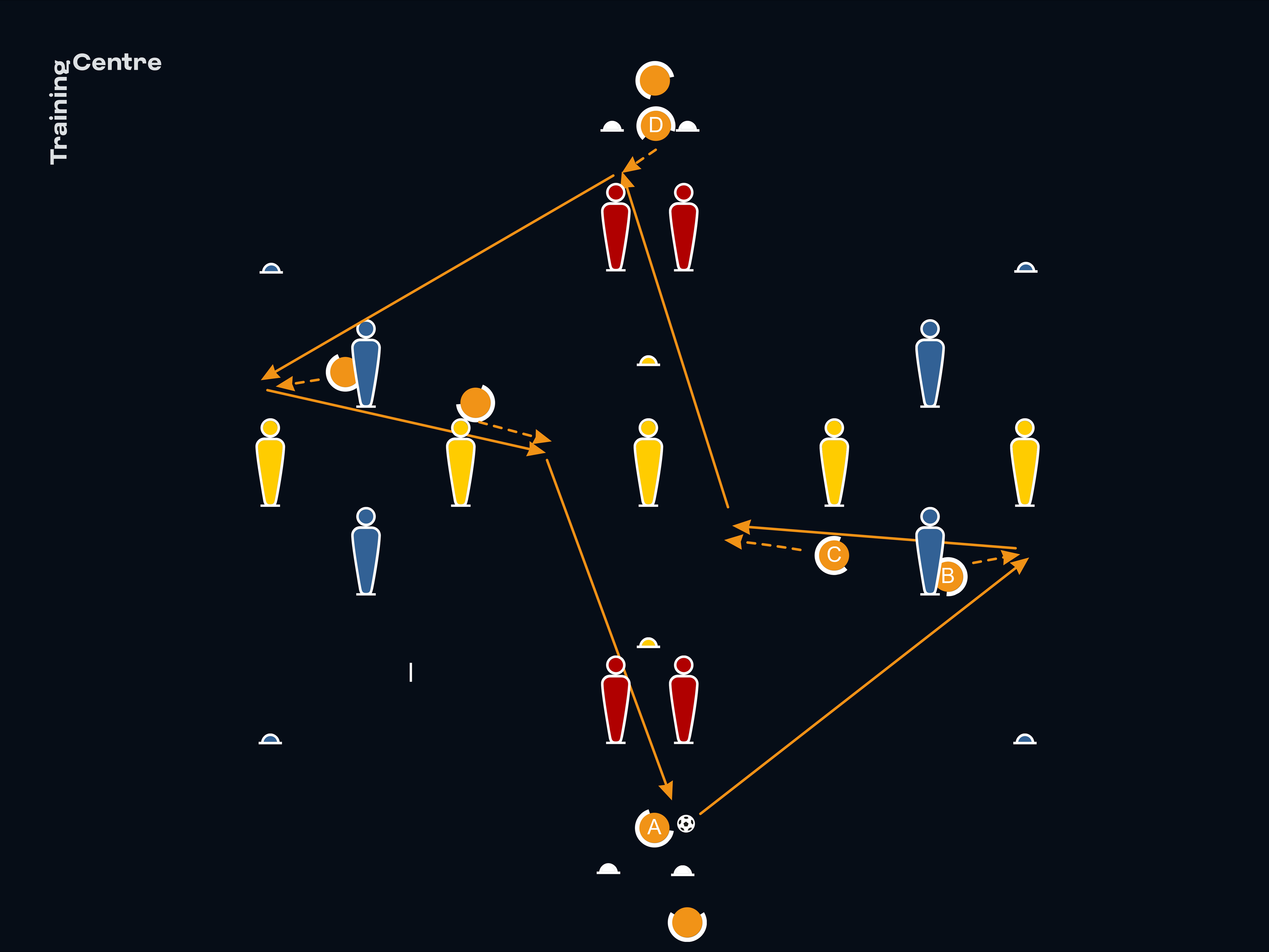
-
A plays a pass to B, who leaves their position next to the blue mannequin gate to receive the pass.
-
B plays a short infield pass to C, who by this point has left their position next to the yellow mannequin to receive the pass.
-
C drives infield on the half-turn with their first touch, before playing a forward pass through the red mannequin gate to D.
-
D then starts the next sequence on the opposite side of the grid.
-
Every player follows their pass so as to ensure rotation.
-
A moves to B.
-
B moves to C.
-
C moves to D.
-
Place the emphasis on getting players to push the ball into space with their first touch, before playing a quality pass into the path of the next player in the sequence with their second touch.
-
Players should play with their heads up and scan the area they are receiving the pass from and the intended destination of their own pass.
-
NB: to promote complete technical balance, the directions should be inverted in the following sequence so as to encourage efficiency of movement and two-footedness.
-
A should look to use their right foot when playing the pass to the right side and use their left foot when playing the pass to the left side.
-
Show quick feet to move away from the mannequin and scan towards C before playing a pass to the position occupied by C.
-
C should quickly scan over their shoulder to D, who is positioned at the starting gate of the second sequence. C should try to play a left-footed pass when playing the ball from their right side to the left and a right-footed pass when playing the ball from their left side to the right in the inverted sequence.
Drill 2: Switch play diagonally, give-and-go in behind
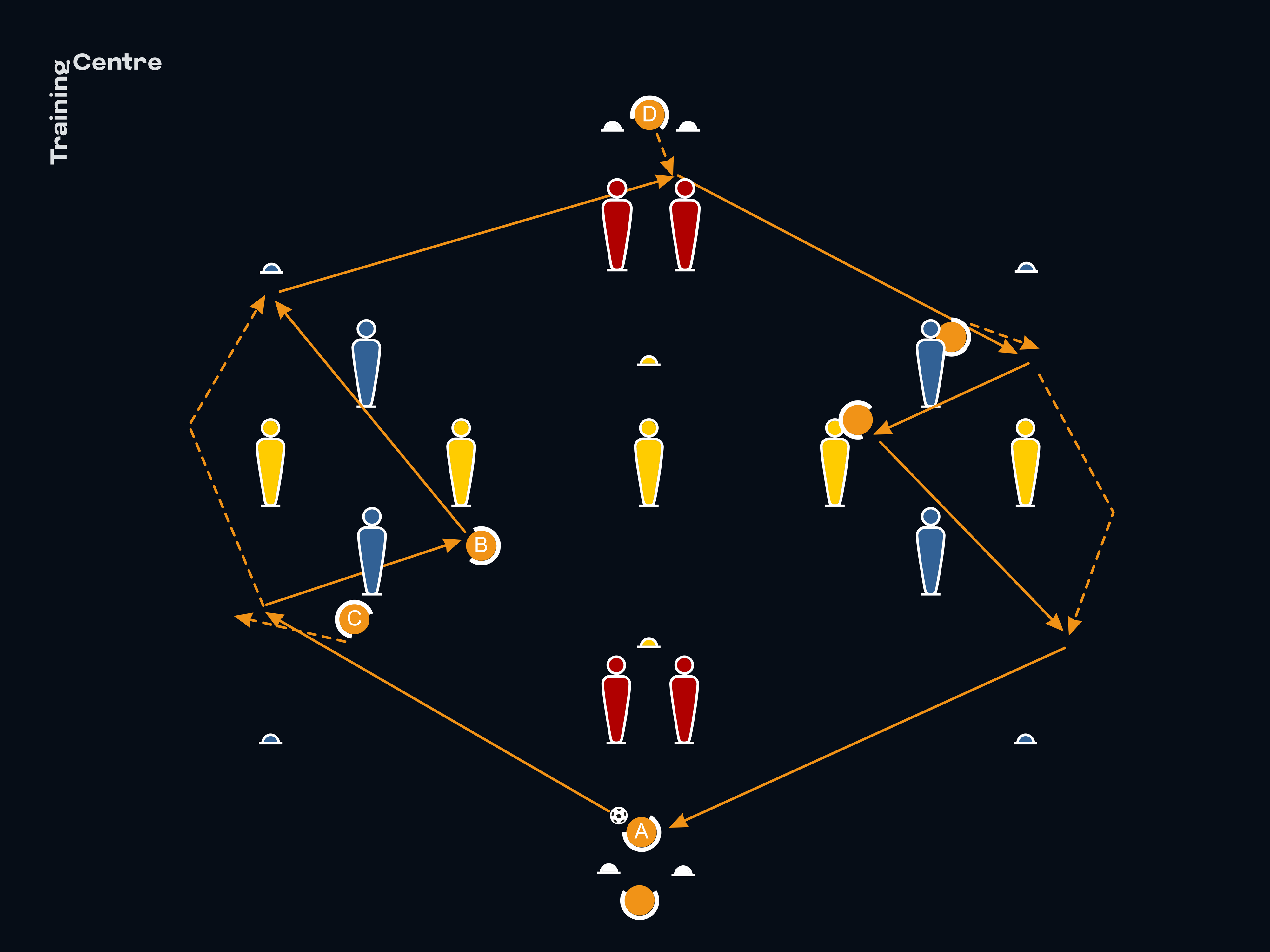
-
A plays the ball out wide to C, who leaves their position next to the blue mannequin to receive the pass.
-
Where possible, C should play a first-time pass between the blue and yellow mannequins to B, before making a run behind the outer yellow mannequin to receive the return pass.
-
B seeks to coordinate the timing of their actions with C in an effort to play a first-time return pass.
-
C plays a diagonal pass to D, who is positioned at the red starting gate at the opposite end of the grid.
-
D then starts the next sequence in the opposite direction.
-
A moves to B.
-
B moves to C.
-
C moves to D.
-
Place the emphasis on playing a quality pass into the path of the next player in the sequence.
-
Players should play with their heads up and scan the area they are receiving the pass from and the intended destination of their own pass.
-
Place special emphasis on the coordination of movement between the wide players to allow them to play first-time passes to each other.
-
NB: to promote complete technical balance, the directions should be inverted in the following sequence so as to encourage efficiency of movement and two-footedness.
-
A should look to play the pass to the left side with their left foot and the pass to the right side with their right foot.
-
Show quick feet to move away from the mannequin and get their head up before playing the pass to C.
-
Before receiving the pass, C should quickly scan over their shoulder to D at the starting gate at the opposite end of the grid. C should look to play a left-footed pass when playing the ball from their left side to the right and a right-footed pass when playing the ball from their right side to the left in the inverted sequence.
Drill 3: Move the game forward by picking out a player’s run between the lines
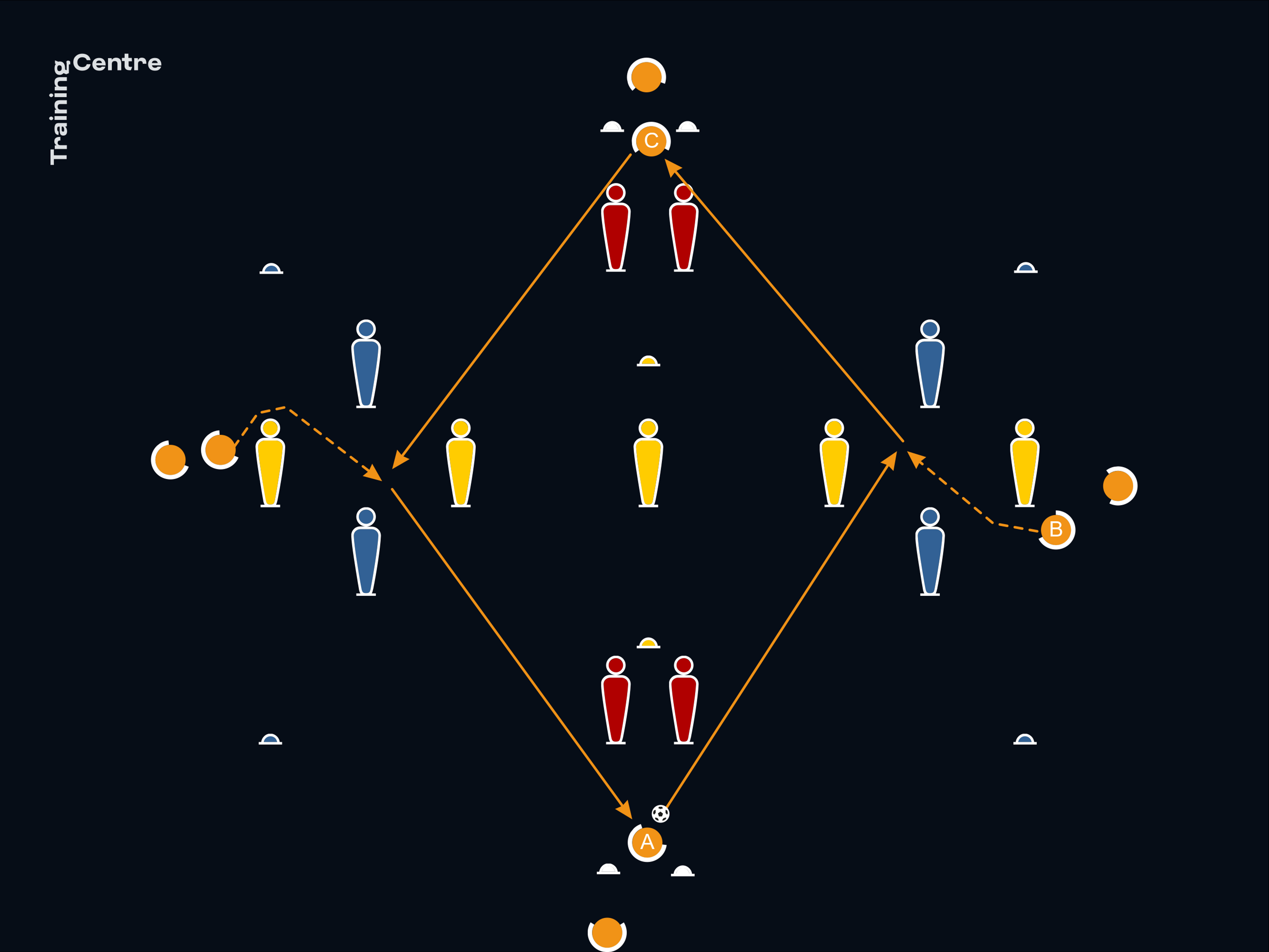
-
A plays a diagonal forward pass between the yellow and blue mannequins to B.
-
B makes a short, angled infield run that is carefully timed to meet A's pass, before playing a diagonal pass to C.
-
C starts the next sequence from the opposite end of the grid.
-
Every player follows their pass so as to ensure rotation.
-
A moves to B.
-
B moves to C.
-
Players should move quickly between positions. Place the emphasis on playing a quality pass into the path of the next player in the sequence.
-
Players should play with their heads up and scan the area they are receiving the pass from and the intended destination of their own pass.
-
NB: to promote complete technical balance, the directions should be inverted in the following sequence so as to encourage efficiency of movement and
two-footedness.
-
The pass played out to the right should involve a right-footed first touch, followed by a right-footed pass. The opposite applies to the inverted sequence on the left side.
-
B should look to play a diagonal left pass with their right foot and a diagonal right pass with their left foot whilst always aiming to play the ball into the path of the receiving player, who is positioned at the gate formed by the two white cones.
-
Particular emphasis should be placed on the timing of B's run between the mannequins and A's pass, which should be coordinated with B's run.
Drill 4: Peel away to create space, turn and pick out the runner in behind
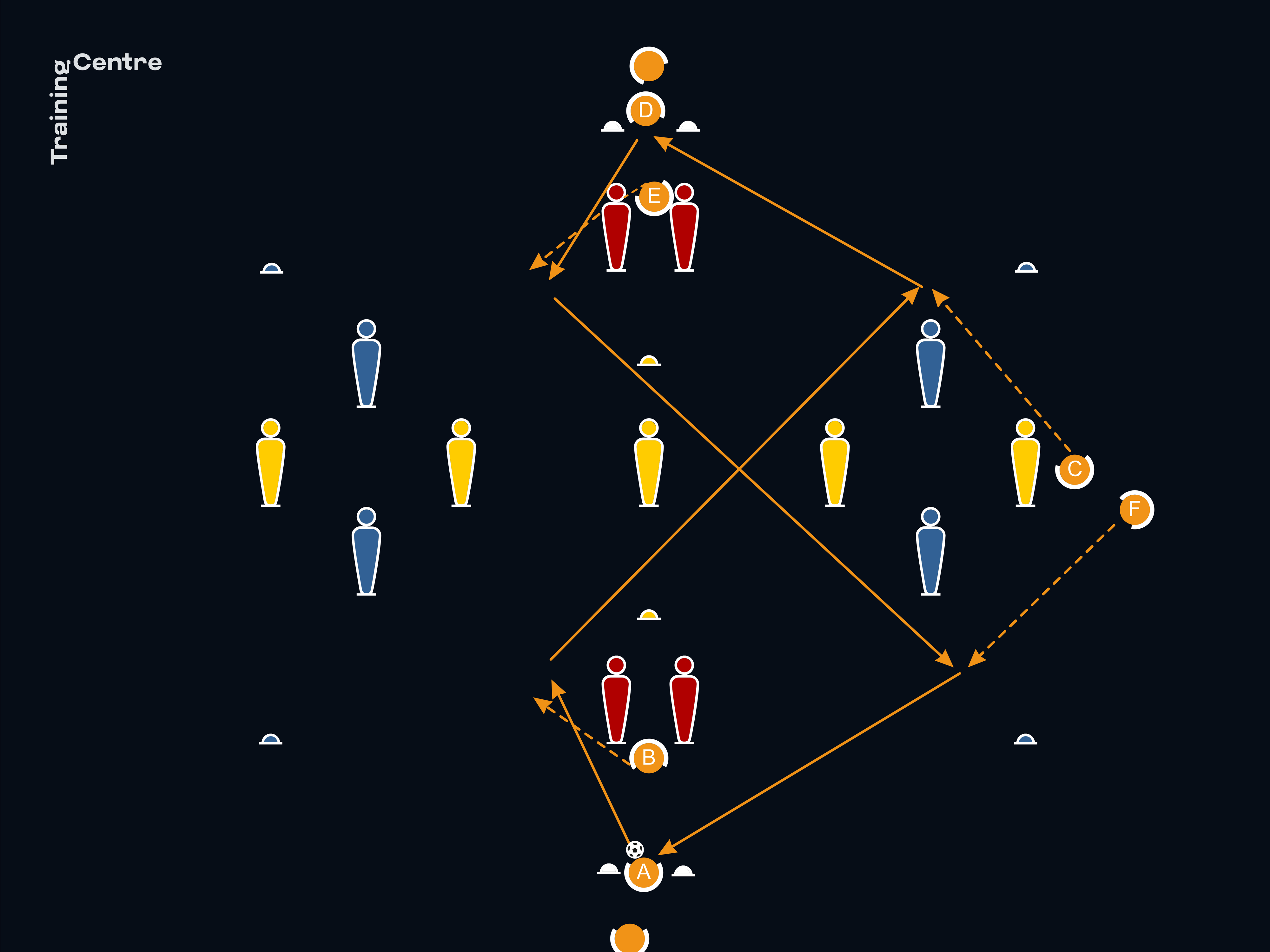
-
A plays a short pass to B, who is positioned next to the nearest red mannequin gate.
-
B shows quick feet to receive A's pass on the half-turn, before turning out and playing a forward diagonal pass in behind and into C's path.
-
C makes a short angled infield run in behind that is timed to meet B's pass, before playing a diagonal pass to D.
-
D then starts the next sequence in the opposite direction.
-
Every player follows their pass so as to ensure rotation.
-
A moves to B.
-
B moves to C.
-
C moves to D.
-
Place the emphasis on playing a quality pass into the path of the next player in the sequence.
-
Players should play with their heads up and scan the area they are receiving the pass from and the intended destination of their own pass.
-
This drill encourages technical balance as it requires players to use their left and right foot in equal measure.
-
The short pass into B's path should be played first-time.
-
B should scan across to C before receiving the pass, then push the ball into space with their first touch and get their head up, before playing a pass into C's path with their second touch.
-
B should play both left- and right-footed passes from both ends of the grid, whilst always looking to use the most appropriate passing foot in the interests of maintaining a high tempo and ensuring the quality of the pass played into C's path.
-
C should look to play the diagonal left pass with their right foot and the diagonal right pass with their left foot, whilst always aiming to play the pass into D's path.
-
Special emphasis should be placed on the timing of C's run to meet B's pass.
Drill 5: Peel away to create space, pick out the runner in behind with a straight pass that meets a curved run
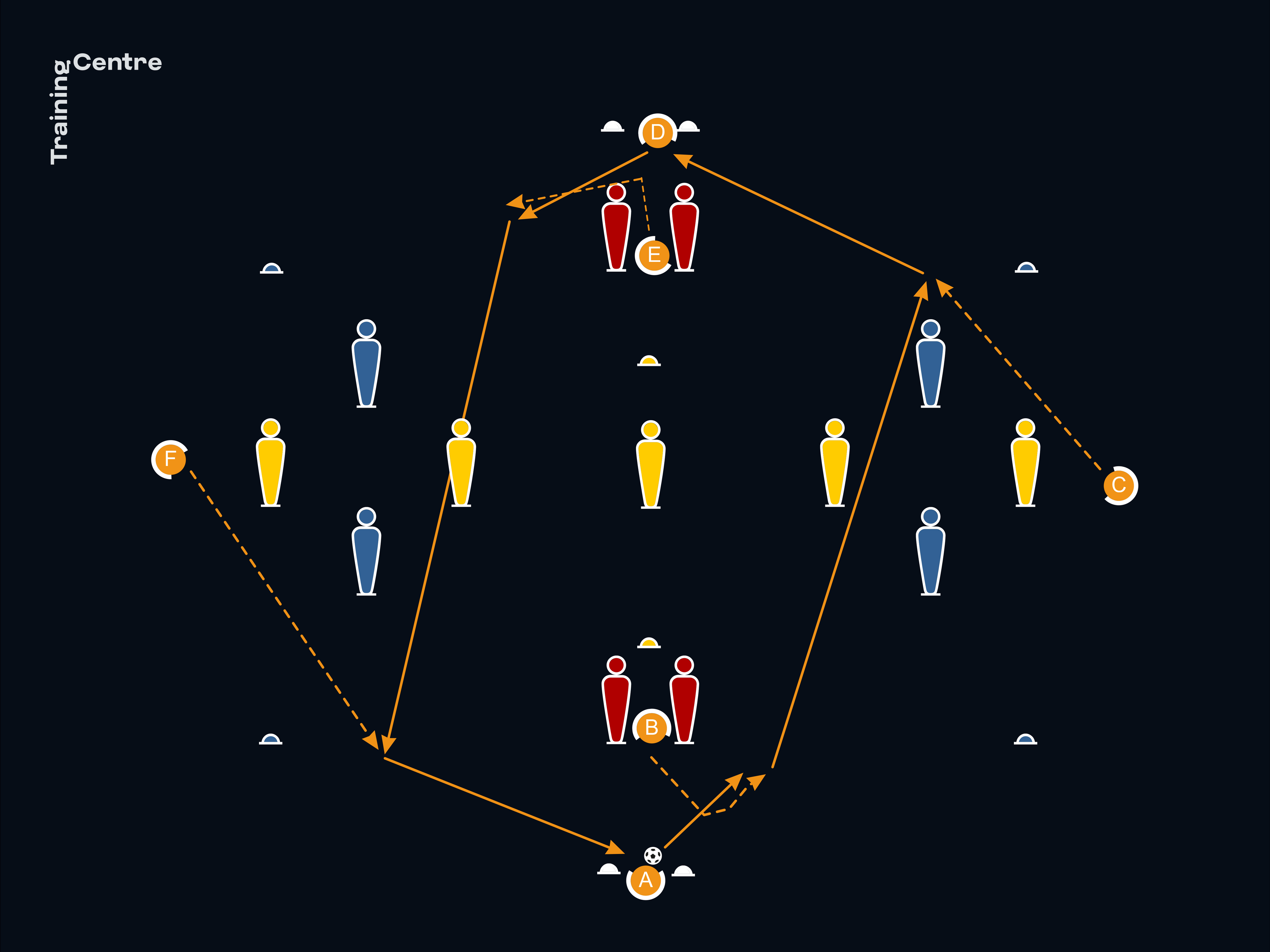
-
A plays a short diagonal pass into the path of B, who makes an angled run to receive the pass.
-
B shows quick feet to peel away from the mannequin gate on the half-turn and receive A’s pass, before playing a forward vertical pass to pick out C's curved run in behind.
-
C makes a curved run in behind that is timed to latch onto the pass played by B between the yellow and blue mannequins, before playing a diagonal pass to D.
-
D then starts the next sequence in the opposite direction.
-
Every player follows their pass so as to ensure rotation.
-
A moves to B.
-
B moves to C.
-
C moves to D.
-
Place the emphasis on playing a quality pass to the next player in the sequence.
-
Encourage efficiency of movement and two-footedness.
-
Players should play with their heads up and scan the area they are receiving the pass from and the intended destination of their own pass.
-
NB: to promote complete technical balance, the directions should be inverted in the next sequence so as to encourage efficiency of movement and two-footedness.
-
B should scan across to C before receiving the pass, then push the ball into space with their first touch and get their head up, before playing a pass into C's path with their second touch.
-
B should look to play a left-footed pass to C when the drill is performed on the left side and play a right-footed pass in the inverted sequence.
-
C should look to play a diagonal left pass with their right foot and a diagonal right pass with their left foot and always aim to play the ball into D's path.
-
Special emphasis should be placed on ensuring that the timing of the run is right to meet B's pass.
Drill 6: Turn out and switch play, turn inside and play forward across the pitch with a pass behind the lines
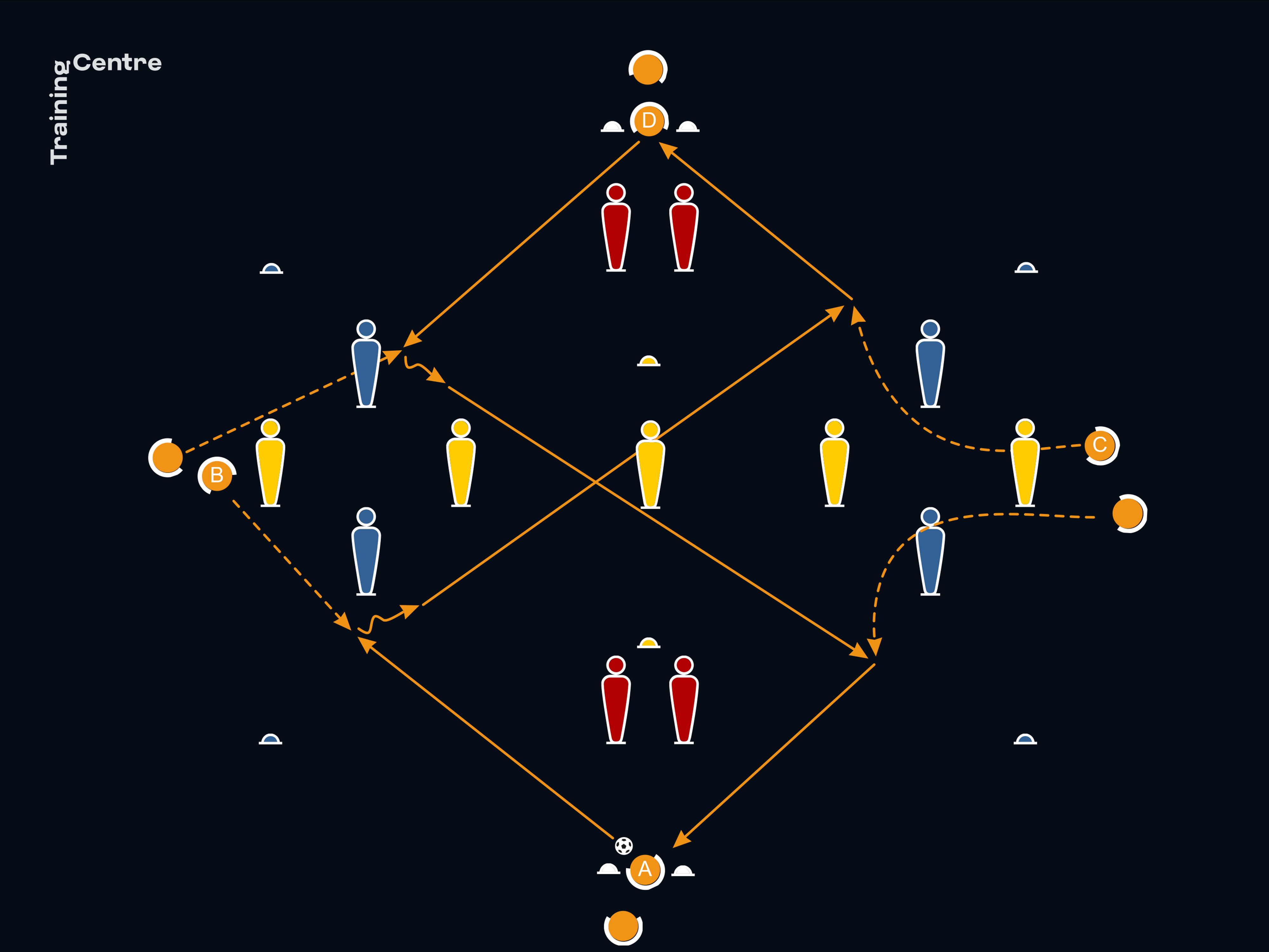
-
A plays a pass out wide to B and towards the position occupied by the blue mannequin.
-
B starts the sequence at the yellow mannequin situated out wide and quickly advances to a position ahead of the blue mannequin to receive A's pass. B then pushes the ball infield with their first touch, before playing a forward pass with their second touch across the grid and behind the line of mannequins situated out wide and into C's path.
-
C starts the sequence at the yellow mannequin positioned out wide on the opposite side of the grid and makes an infield run to latch onto B's pass, before playing a diagonal pass to D.
-
D then starts the next sequence in the opposite direction.
-
Every player follows their pass so as to ensure rotation.
-
A moves to B.
-
B moves to C.
-
C moves to D.
-
Place the emphasis on playing a quality pass to the next player in the sequence.
-
Players should play with their heads up and scan the area they are receiving the pass from and the intended destination of their own pass.
-
This drill encourages technical balance as it requires players to use their left and right foot in equal measure.
-
When playing the pass out wide to the left, A should look to shift the ball into space with a left-footed first touch, before playing a left-footed pass with their second touch. The opposite applies when the drill is performed on the right side.
-
When playing the pass from left to right across the grid, B should look to use their right foot, and play a left-footed pass when playing the ball from the right to the left of the grid.
-
Special emphasis should be placed on the quality of the first touch that sees B shift the ball infield before playing a pass to C with their second touch.
-
Emphasis should be placed on coordinating the movement of C's run with B's movement and touch.
Drill 7: Step in to meet the ball, lift head up and play a diagonal pass in behind
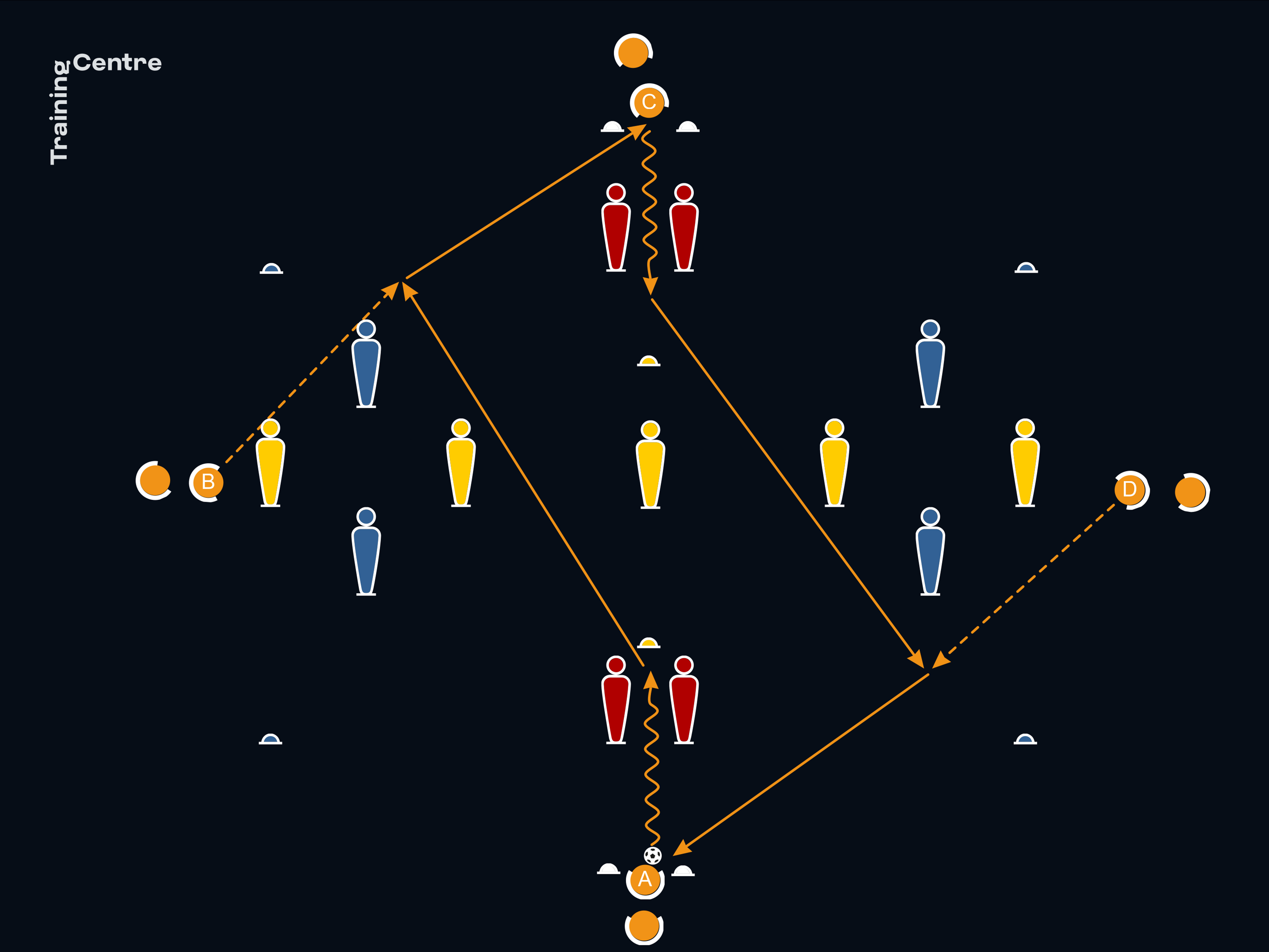
-
A pushes the ball through the red mannequin gate with their first touch, before passing out wide to B with their second touch.
-
B sets out from the yellow mannequin and makes a carefully timed infield run that is coordinated with A’s run and pass, before playing a diagonal pass to C, who is situated at the red mannequin gate at the opposite end of the grid.
-
C then starts the next sequence in the opposite direction.
-
Every player follows their pass so as to ensure rotation.
-
A moves to B.
-
B moves to C.
-
Place the emphasis on playing a quality pass into the path of the next player in the sequence.
-
Players should play with their heads up and scan the area they are receiving the pass from and the intended destination of their own pass.
-
NB: to promote complete technical balance, the directions should be inverted so as to encourage efficiency of movement and two-footedness.
-
When playing a diagonal forward pass to the left, A should look to play a right-footed pass. The opposite applies when the drill is performed on the right side, where a left-footed pass should be played.
-
Special emphasis should be placed on the quality of the first touch that sees the player push the ball through the red mannequin gate as this touch lays the foundations for the subsequent pass to B.
-
Place the emphasis on the coordination of movement between B's run from the yellow mannequin and A’s movement as they push through the gate.
Drill 8: Turn and play diagonally, play a return pass, pick out 3rd player who runs in behind
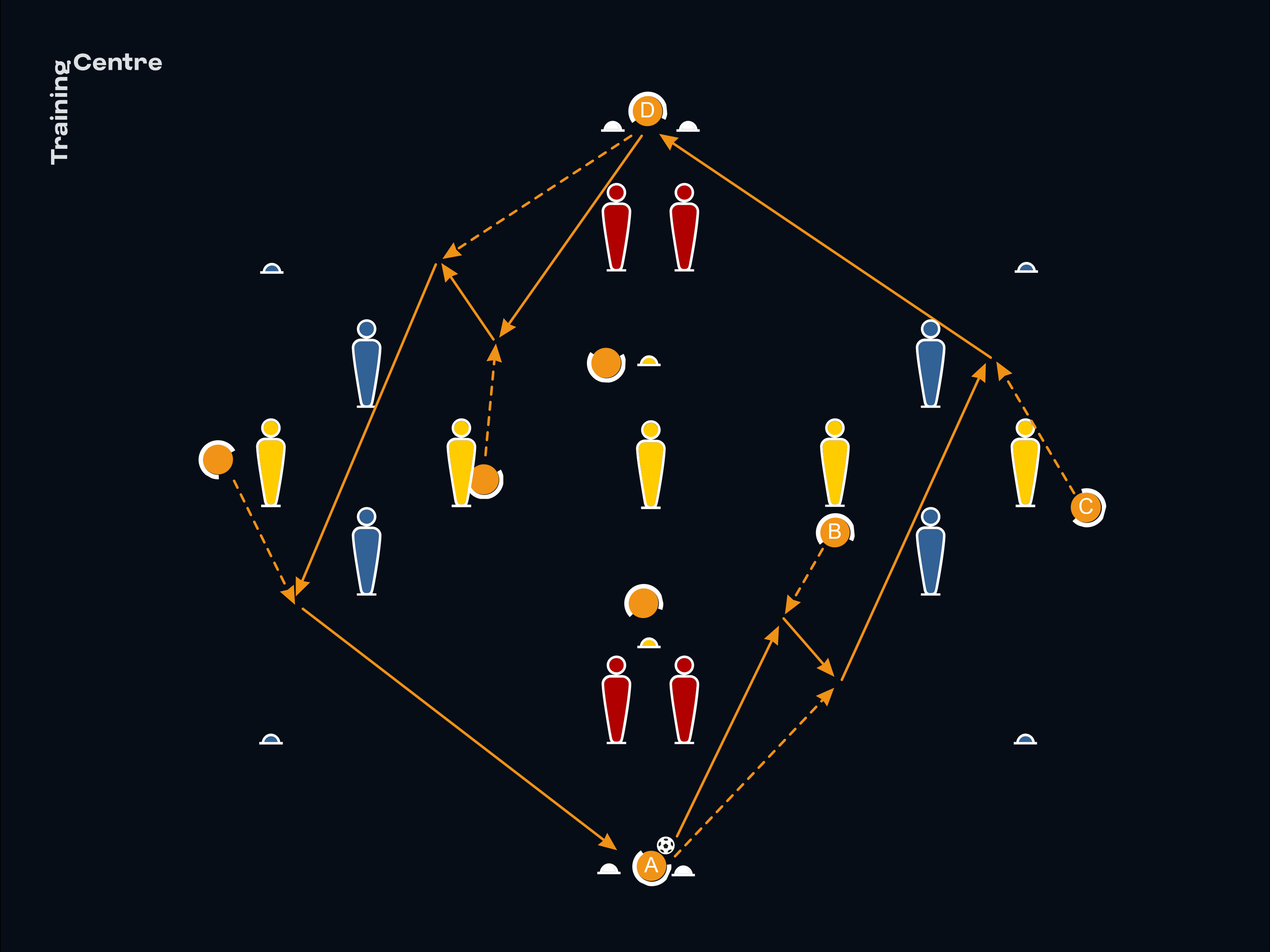
-
A plays a diagonal forward pass to B, who is positioned at the nearest yellow mannequin, before advancing to receive the return pass and playing a diagonal forward pass between the blue and yellow mannequins out wide to pick out C's run.
-
B advances and plays a first-time return pass into A's path.
-
C drives forward from behind the yellow mannequin situated out wide with a carefully timed run to meet A's pass, before playing a diagonal pass to D, who is positioned at the red mannequin gate at the opposite end of the grid.
-
D then starts the next sequence in the opposite direction.
-
Every player follows their pass so as to ensure rotation.
-
A moves to B.
-
B moves to C.
-
C moves to D.
-
Place the emphasis on playing a quality pass into the path of the next player in the sequence.
-
Players should play with their heads up and scan the area they are receiving the pass from and the intended destination of their own pass.
-
From the second sequence, A/D should make a timed run from their starting position at the red cone through the red mannequin gate before turning to meet C's pass.
-
Special emphasis should be placed on collective understanding and the quality of the movement, timing and passing between A, B and C.
-
NB: to promote complete technical balance, the directions should be inverted so as to encourage efficiency of movement and two-footedness.
-
When passing the ball out to the right to B, A should look to shift the ball into space with a right-footed first touch, before playing a right-footed pass with their second touch. When passing the ball out to the right to C, A should also play a right-footed pass. The opposite applies when the drill is performed on the left side, when both passes are to be left-footed.
-
C should look to play a diagonal right pass with their left foot and a diagonal left pass with their right foot, whilst always aiming to play the ball into the path of A/D at the red mannequin gate.
-
The line formed by the yellow mannequins also serves to mark offside. C should time their run to ensure that they are not in an offside position when receiving A's pass.











